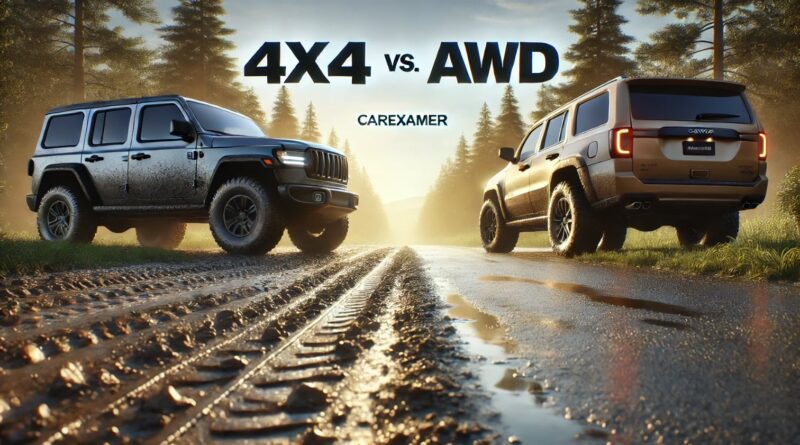Difference Between 4×4 and AWD and Which Is Right for You?
Here’s a simple breakdown of Difference Between 4×4 and AWD and some tips to help you decide which option might be right for you. When shopping for a vehicle, especially if you’re looking at SUVs, trucks, or crossovers, you’ll come across terms like 4×4 (Four-Wheel Drive) and AWD (All-Wheel Drive). Both systems send power to all four wheels to improve traction and stability, but they work differently and are best for different types of driving.
1. What Does 4×4 (Four-Wheel Drive) Mean?
4×4, or Four-Wheel Drive (4WD), is a drivetrain system designed to send power to all four wheels when needed, especially in rough conditions. You’ll often find 4×4 in off-road vehicles like trucks and large SUVs. With most 4×4 systems, you can switch between two-wheel drive (2WD) for regular driving and four-wheel drive (4WD) for rough terrain or challenging conditions, giving you more control and grip on tricky surfaces.
How 4×4 Works:
- Selectable 4WD: Most 4×4 systems let you manually switch from 2WD to 4WD. In 4WD mode, power is distributed to all four wheels equally, giving extra traction on rough or slippery terrain.
- High and Low Gears: Some 4×4 vehicles come with high and low gear options. Low-range gearing gives more torque, which is useful for driving over steep hills, mud, sand, or rocky surfaces.
Pros of 4×4:
- Great for Off-Roading: 4×4 is built for challenging off-road conditions, like trails, mud, snow, and steep inclines.
- Extra Control on Rough Terrain: All four wheels work together to give you the grip you need on tough surfaces.
Cons of 4×4:
- Lower Fuel Efficiency: 4×4 systems are heavier and less fuel-efficient, especially when 4WD mode is on.
- Heavier Handling: 4×4 vehicles are often built for durability, making them harder to maneuver in tight city spaces.
When to Choose 4×4:
- If You Love Off-Roading: 4×4 is perfect for people who enjoy outdoor adventures and need a vehicle that can handle rough, uneven terrain.
- If You Drive in Extreme Conditions: A 4×4 vehicle is ideal for areas with lots of snow, mud, or steep hills.
Examples of 4×4 Vehicles:
- Jeep Wrangler
- Toyota Land Cruiser
- Ford F-150 (with 4×4 option)
2. What Is AWD (All-Wheel Drive)?
AWD, or All-Wheel Drive, automatically sends power to all four wheels without you needing to do anything. Unlike 4×4, AWD is designed to work on its own, adjusting the power distribution to each wheel based on road conditions. You’ll commonly see AWD in crossovers, sedans, and compact SUVs because it provides extra stability and traction on the road, especially in poor weather.
How AWD Works:
- Full-Time AWD: Some AWD systems are always on, sending power to all four wheels and adjusting as needed based on traction.
- Automatic Adjustment: AWD uses sensors to detect road conditions and automatically adjusts which wheels get more power for the best stability and control.
Pros of AWD:
- Smooth Handling in Wet or Icy Conditions: AWD provides added control and stability, especially on slippery roads.
- No Switching Needed: AWD automatically kicks in when it senses slippery conditions, so you don’t have to worry about activating anything.
Cons of AWD:
- Not Built for Serious Off-Roading: While AWD offers good traction, it doesn’t have the low-range gearing needed for extreme off-road adventures.
- Higher Maintenance: AWD systems are complex and may require more maintenance than simpler 4×4 systems.
When to Choose AWD:
- For Everyday Driving in Poor Weather: AWD is a good choice if you need extra traction for rain, light snow, or icy roads but aren’t planning on off-roading.
- If You Want Easy Handling and Safety: AWD makes everyday driving in tricky weather safer without you having to think about it.
Examples of AWD Vehicles:
- Subaru Outback
- Honda CR-V
- Audi Quattro models
3. 4×4 vs. AWD: What’s the Difference?
| Feature | 4×4 (Four-Wheel Drive) | AWD (All-Wheel Drive) |
|---|---|---|
| Driver Control | You manually engage 4WD | AWD engages automatically |
| Best Use | Off-road, rough or extreme terrain | On-road, slippery conditions |
| Traction Handling | High and low-range gears for control | Power automatically adjusted to wheels |
| Fuel Efficiency | Less fuel-efficient | More efficient than 4×4 |
| Maneuverability | Built rugged, less agile | Smoother handling on paved roads |
| Maintenance | Simpler maintenance | More complex, may require extra care |
4. Which One Should You Choose?
The best choice between 4×4 and AWD depends on where and how you plan to drive:
- Choose 4×4 if you’re into off-roading, live in a rural area, or regularly drive in challenging conditions. 4×4 will give you the extra power and traction to handle rough terrain and extreme weather.
- Choose AWD if you mostly drive on paved roads but want extra stability and safety when things get slippery. AWD is ideal for everyday drivers who need a bit more control in wet, icy, or snowy conditions but don’t need serious off-road capability.
5. Summary: 4×4 vs. AWD
Both 4×4 and AWD systems offer better traction and control, but they’re designed for different driving needs. 4×4 shines off-road, giving you the power to tackle rugged landscapes and handle extreme conditions. AWD, meanwhile, is perfect for everyday driving in bad weather, making it safer and easier to handle roads with occasional snow, rain, or ice.
By knowing the strengths and limitations of each system, you’ll be better equipped to pick a vehicle that fits your lifestyle and driving environment.
Buying a used VW. Buying used vauxhall, BMW, Jaguar, Ford, Volvo, Range rover, Bentley, Aston Martin, Porsche, Ferrari, Lamborghini, Maserati, Hyundai, Tesla, Honda, Pagani

